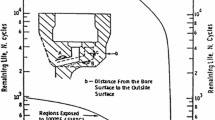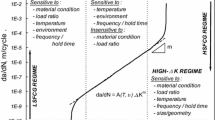Abstract
The current status of activities associated with the assessment of conditions and prospects for prolonging the service life of equipment operating for a long time at thermal power stations (TPS) is described. The history of the creation and development of an industry system for diagnosing and prolonging the lifetime of heat-generating and mechanical equipment is briefly outlined. The core of the system was the results of investigations into long-term strength and creep of heat-resistant steels, and a regulatory base governing effective application of the system was formed and continuously improved within the system framework. It is noted that more and more extensive investigations resulted in the attempts to extend the criterial strength base using the cracking resistance criteria, including local creep fracture criteria. The advantages and disadvantages of the most-used local control method, i.e., the replica method, are analyzed. It is proposed to use the fracture mechanics criteria and, in particular, the threshold stress intensity factor (SIF) below which creep cracking does not occur in analyzing the process of steel creep fracture. It is demonstrated that the threshold SIF for a specific material depends functionally not only on the temperature but also on the loading time. Considering this fact, it is proposed to account for the accumulation of local (at the crack tip) and total damageability of the metal in the concept of threshold SIF. A similar approach can also be used for describing the subcritical crack growth. Therefore, it is proposed to construct crack growth diagrams using isochronous curves for the specified test times. It is demonstrated that dimensions of allowable flaws that do not lead to crack propagation can be predicted for given operating conditions. The cases were analyzed that occurred while obtaining results of examination of a structural member operating under creep conditions for prediction of the size of allowable (nonpropagating) crack-like flaws. This analysis has revealed that the application of the threshold SIF criterion and isochronous creep crack growth rate diagrams can be useful for setting forth the substantiated frequency of examinations for high-temperature equipment and establishing the time by which the equipment service life can be prolonged.
Similar content being viewed by others
References
RD 10-577-03. Model Guidelines for Inspection of Metal and Prolongation of the Service Life of Main Components of Boilers, Turbines, and Piping Systems of Thermal Power Stations (Promyshlennaya Bezopasnost’, Moscow, 2004).
RD 10-249-98. Standards for Strength Analysis of Stationary Boilers and Steam and Hot Water Piping (Promyshlennaya Bezopasnost’, Moscow, 2002).
Regularities of Creep and Long-Term Strength: Handbook, Ed. by S. A. Shesterikov (Mashinostroenie, Moscow, 1983) [in Russian].
A. A. Chizhik and Yu. K. Petrenya, “On kinetic equations of damageability in resource and reliability evaluation of materials under creep conditions,” Tr. TsKTI, No. 194, 27–77 (1982).
I. I. Gol’denblat, V. L. Bazhanov, and V. A. Konnov, Long-Term Strength in Machine Construction (Mashinostroenie, Moscow, 1977) [in Russian].
A. V. Stanyukovich, Brittleness and Ductility of Heat-Resistant Materials (Metallurgiya, Moscow, 1987) [in Russian].
L. B. Getsov, Materials and Strength of Gas Turbine Parts (Nedra, Moscow, 1996) [in Russian].
Yu. K. Petrenya, “Long-term strength during intercrystalline fracture under conditions of complex stress state,” Tr. TsKTI, No. 177, 89–98 (1980).
K. V. Frolov, V. K. Ryzhkov, N. A. Makhutov, and A. A. Chizhik, “Individual resource estimation methods and interrepair time of power equipment,” Tr. TsKTI, No. 194, 4–21 (1982).
A. A. Lanin and V. A. Artamonov, “Problems of fracture resistance evaluation of basic parts of steam turbines,” Tr. TsKTI, No. 246, 100–118 (1988).
G. J. Frost and M. F. Ashby, Deformation-Mechanism Maps: The Plasticity and Creep of Metals and Ceramics (Pergamon, Oxford, 1982; Metallurgiya, Chelyabinsk, 1989).
E. A. Grin’, “The possibilities of fracture mechanics as applied to problems of strength, service life, and substantiation of safe operation of heat-generating and mechanical equipment,” Therm. Eng. 60, 24–31 (2013). doi 10.1134/S004060151301001
J. Cadek, Creep in Metallic Materials (Elsevier, Amsterdam, 1988; Mir, Moscow, 1987).
A. A. Lanin, “Phenomenological regularities pertinent to development of brittle local fractures at high-temperature creep,” Therm. Eng. 60, 46–53 (2013). doi 10.1134/S0040601513010059
N. A. Makhutov, E. A. Grin’, and V. A. Sarkisyan, “Crack growth kinetics in power plant engineering steels in high-temperature creep,” Zavod. Lab. Diagnostika Mater. 81 (11), 44–52 (2015).
Author information
Authors and Affiliations
Corresponding author
Additional information
Original Russian Text © A.A. Lanin, E.A. Grin’, 2018, published in Teploenergetika.
Rights and permissions
About this article
Cite this article
Lanin, A.A., Grin’, E.A. An Approach to Assessment of the Lifetime Characteristics of Steels under Creep Conditions Using Fracture Mechanics Criteria. Therm. Eng. 65, 239–245 (2018). https://doi.org/10.1134/S0040601518040031
Received:
Accepted:
Published:
Issue Date:
DOI: https://doi.org/10.1134/S0040601518040031




